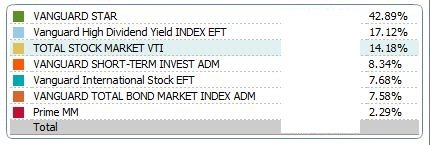We're at 9 funds:
Vanguard Total Stock Market Admiral Fund
Vanguard Small-Cap Value Admiral Fund
Vanguard REIT Index Admiral Fund
Vanguard European Admiral Fund
Vanguard Pacific Admiral Fund
Vanguard Emerging Markets Institutional Fund
Vanguard FTSE ex-US Small Cap ETF
Vanguard Total Bond Institutional Fund
Vanguard Wellesley Admiral Fund
50/50 between us/intl. About 25% in FI, but about 15% of that is now Wellesley, which we added to our portfolio this last year.
I always debate if I should go with a total international instead of splitting it over 3 funds, but I think there's a bonus to be had and it's not that much more work.
Vanguard Total Stock Market Admiral Fund
Vanguard Small-Cap Value Admiral Fund
Vanguard REIT Index Admiral Fund
Vanguard European Admiral Fund
Vanguard Pacific Admiral Fund
Vanguard Emerging Markets Institutional Fund
Vanguard FTSE ex-US Small Cap ETF
Vanguard Total Bond Institutional Fund
Vanguard Wellesley Admiral Fund
50/50 between us/intl. About 25% in FI, but about 15% of that is now Wellesley, which we added to our portfolio this last year.
I always debate if I should go with a total international instead of splitting it over 3 funds, but I think there's a bonus to be had and it's not that much more work.


